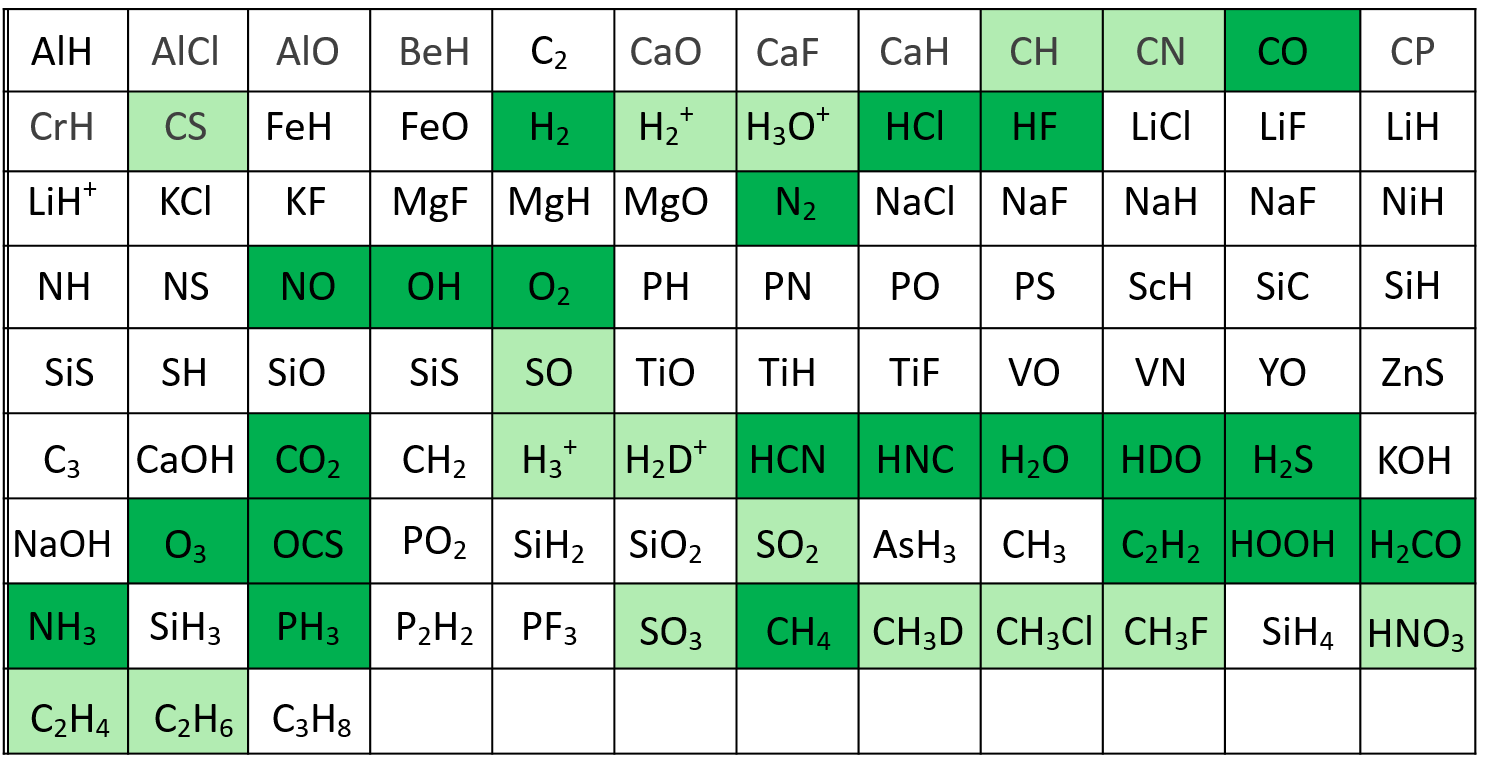Provision of high-definition pressure-broadening data for spectroscopic studies of exoplanetary atmospheres: ExoMol Diet 1.2
- 1Institut UTINAM UMR CNRS 6213, Université Bourgogne Franche-Comté, 16 Route de Gray, 25030 Besançon cedex, France (jeanna.buldyreva@univ-fcomte.fr)
- 2Department of Physics and Astronomy, University College London, Gower Street, WC1E 6BT London, United Kingdom
Spectroscopic studies of exoplanetary atmospheres by the next generation space missions, such as the James Webb Space Telescope (JWST) and Atmospheric Remote-sensing Exoplanet Large-survey (ARIEL), will rely on spectroscopic data available at mid-infrared and visible/infrared wavelengths for the bulk of already detected or expected molecules. While in gas giants the main perturbers are hydrogen (H2) and helium (He), due to the large variety of exoplanet atmospheres to be probed, a whole range of other broadeners are also of interest, including carbon dioxide (CO2), nitrogen (N2), oxygen (O2), water vapor (H2O), carbon monoxide (CO), nitric monoxide (NO), methane (CH4) and ammonia (NH3). Moreover, because of the elevated temperatures encountered, not only “exotic” molecules but also molecular ions have to be considered as optically active species.
Several spectroscopic databases (e.g., HITRAN [1], GEISA [2], ExoMol [3], TheoReTS [4] and MoLList [5]) provide extensive line lists of positions and intensities of isolated spectral transitions, some of which contain many billions of lines. However, the associated pressure-broadening and shift parameters, as well as their temperature dependences, remain poorly determined or completely missing (see Figure). In addition, due to the specific conditions of hot atmospheres and chemical reactions which lead to the formation of spectroscopically active species, laboratory studies are extremely scarce in both infrared/microwave (IR/MW) and visible/ultraviolet(UV) regions. Therefore, there is a huge demand for robust theoretical approaches and estimates that could provide line-shape parameters for a large range of excitations covering wide ranges of temperatures and pressures and large variety of perturbers.

Figure: Availability of line broadening parameters in spectroscopic databases: missing (white), limited coverage (light green) and good coverage (dark green).
In this work, we introduce recipes for getting reasonable estimates of pressure line-broadening parameters and their temperature dependences for IR/MW (vibrotational) and UV (vibronic) transitions for molecules relevant to exoplanetary atmospheres including “exotic” neutral and ionic species (such as NO+, HCO+, H3O+, HeH+ and H3+, NH4+).
The existing classical, quantum-mechanical and semi-classical theoretical approaches to collisional line-broadening and shifting used for the IR/MW region require pre-computed reliable potential-energy surfaces and CPU-costly calculations for each collisional pair. Here we suggest a simple theoretical expression requiring a minimal set of input parameters (kinetic molecular properties and the character of the leading term in the intermolecular interaction potential) [6]. Good consistency with available measurements over the temperature range 200-3000 K is demonstrated for NO and OH colliding with rare-gas atoms and non-polar molecules. Not only active neutral molecules but also molecular ions such as NO+, HCO+, H3O+, HeH+ (which have permanent dipole moments) and H3+, NH4+ (with only transition dipole moments) can be treated by this approach.
In addition to the recipe for getting estimates, for the IR/MW region we consider traditional semiclassical calculation methods combined with accurate variational wavefunctions for large-scale calculations: a new program for computing line widths and shifts, based on the use of ExoMol ro-vibrational wavefunctions to compute the key (reduced) matrix elements. Given the large number of molecules, transitions, broadeners and range of temperatures required, we also explore the use of machine learng methods trained on data for selected systems to compute comprehensive and very large rotation-vibration and rovibronic pressure-broadening parameters.
For the UV region, where the lack of the line-shape data is especially critical, more accurate models, motivated by the known effect of the strongly dominating adiabatic collisions and based on the Fourier-integral/phase-shift theory, are introduced to take account of real molecular trajectories and very different interaction potentials of the active molecule in the initial and final states. Examples of applications for line lists from the ExoMol database are given.
The theoretical models presented will be incorporated into an updated ExoMol diet [7] to provide default line-broadening parameters when none are available from other sources and will be used to develop stand-alone approaches for automatic, large-scale production of collisional widths/shifts for line lists containing billions of transitions for molecules of interest for atmospheres of exoplanets.
References
[1] I.E. Gordon, L.S. Rothman, R.J. Hargreaves et al., J. Quant. Spectrosc. Radiat. Transfer 277, 107949 (2022)
[2] N. Jacquinet-Husson et al., J. Mol. Spectrosc. 327, 31 (2016)
[3] J. Tennyson, S.N. Yurchenko, A. F. Al-Refaie et al., J. Quant. Spectrosc. Radiat. Transfer 255, 107228 (2020)
[4] A.V. Nikitin, Y.L. Babikov, V. G. Tyuterev, J. Mol. Spectrosc. 327, 138 (2016)
[5] P.F. Bernath, J. Quant. Spectrosc. Radiat. Transfer 240, 106687 (2020)
[6] J. Buldyreva, S.N. Yurchenko, J. Tennyson, RASTI 2022 (under revision)
[7] E.J. Barton et al., J. Quant. Spectrosc. Radiat. Transfer 203, 490 (2017)
How to cite: Buldyreva, J., Yurchenko, S., Guest, E., Sokolov, A., and Tennyson, J.: Provision of high-definition pressure-broadening data for spectroscopic studies of exoplanetary atmospheres: ExoMol Diet 1.2, Europlanet Science Congress 2022, Granada, Spain, 18–23 Sep 2022, EPSC2022-1171, https://doi.org/10.5194/epsc2022-1171, 2022.

